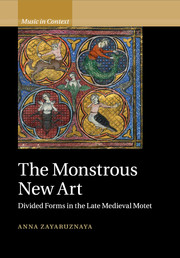The newly reconstructed motet Beatius/Cum humanum is remarkable in several respects. It ranks among the longest of Ars Nova motets, and divides neatly into three parts of which the middle is an eighty-breve untexted hocket section. It also contains an extended quotation – textual as well as musical – from the Fauvel motet Firmissime/Adesto. The quoted material speaks of ‘Trinity and unity’, turning a spotlight onto the tripartite form of Beatius/Cum humanum. Firmissime/Adesto has occasioned comment because it is built up of duple (‘imperfect’) notes even though it praises the perfect Trinity. Beatius/Cum humanum can be read as participating in the same conversation. By shifting the salience of the number three from local rhythmical organisation to the global level of form, it serves as an example of how music can depict perfection ex imperfectis.
